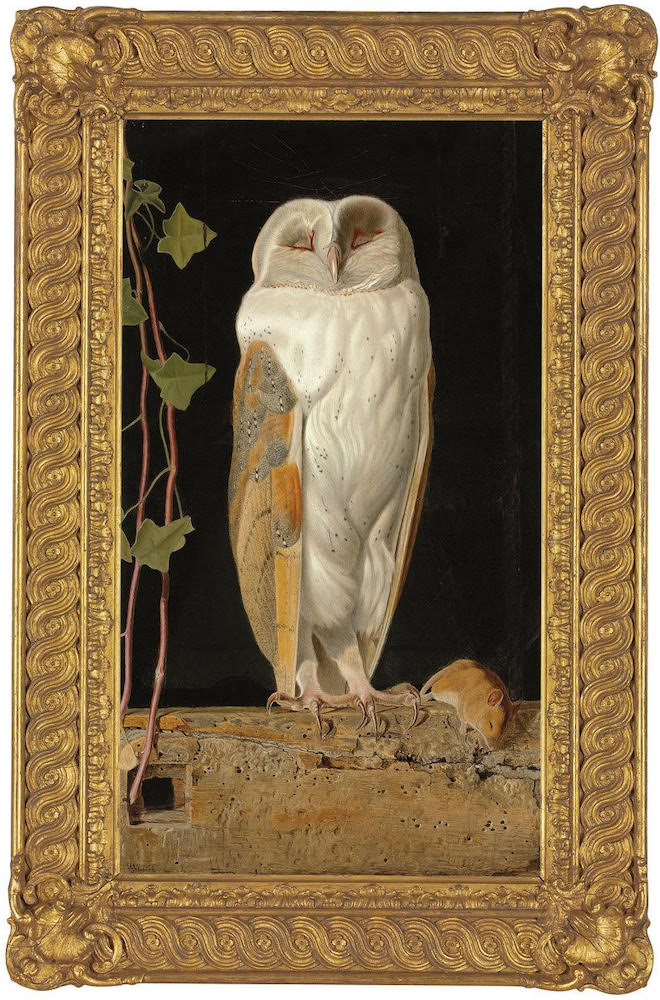

The White Owl by William J. Webb(e) (1830-1912[?]). Signed in monogram and dated 1856 lower left. Oil on board. 17 3/4 x 10 3/8 inches (45 x 26.3 cm). Image by kind permission of Christie's. Right click disabled; not to be downloaded.
The style of his paintings, with their detail and high colour, and the religious and allegorical content of his paintings, — but chiefly his visits to the East — declare him as a follower of Holman Hunt. One may imagine that this painting was a tribute to Hunt's technical approach to The Light of The World, although whether the same procedures were carried out is open to doubt, and the allegorical content, if any, is obscure. — Anthea Brooke
Ruskin briefly commented in his 1856 Academy Notes: "A careful study — the brown wing excellent. The softness of an owl's feathers is perhaps inimitable; but I think the breast might have come nearer the mark" (14.51) — George P. Landow.
Commentary by Dennis T. Lanigan
This is likely the painting, that Webb(e) exhibited at the Royal Academy in 1856, no. 59, although another autograph version of this same subject, also dating from 1859, is known to exist. The version shown at the Royal Academy was accompanied in the catalogue by these lines from Tennyson's short poem, "The Owl": "Alone and warming his five wits,/ The white owl in the belfry sits." Appropriately, considering the subject, this painting was once in the collection of the distinguished English biologist Professor Richard Owen who since 1836 had been Hunterian Professor of Comparative Anatomy and Physiology at the Royal College of Surgeons.
The White Owl or Screech Owl (Tyto alba) is a barn owl popular with farmers for keeping the population of rats and mice down in farm buildings. Everything in Webb's picture is painted in great detail with Pre-Raphaelite precision. The owl, perched on a wooden beam, has obviously recently killed the mouse seen to the right of its talons. This type of owl can be identified by its heart-shaped face flat face, its golden and brown back and wings, and its white underparts. Ivy is shown growing to the right of the owl, probably for decorative rather than symbolic purposes.
Contemporary Reviews of the Painting
A reviewer for The Athenaeum felt Webb(e)'s work was one of the best examples of animal painting in the R. A. exhibition: "In animal painting, after Sir Edward [Landseer], we have not much to interest. We must except a careful and promising little picture, wonderful in execution, though rather hard and flat, — the White Owl (59), by Mr. W. J. Webb" (622).
As noted by Landow, Webb(e)'s The White Owl was admired by Ruskin, who saw it as one of the pictures by the "rising school" that he singled out for praise in his Academy Notes.
Bibliography
Brooke, Anthea. Victorian Painting. Catalogue for exhibition November-December 1977. London: Fine Art Society, 1977.
"Fine Arts. Royal Academy." The Athenaeum No. 1490 (17 May 1856): 620-23.
Fine Victorian Paintings, Drawings and Watercolours. London: Sotheby's Belgravia (14 June 1977, lot 31, 15.
Ruskin, John. "Academy Notes." The Works of John Ruskin. Vol. XIV. Edited by E.T. Cook and Alexander Wedderburn. London: George Allen, 1904. 51.
Victorian and British Impressionist Art. London: Christie's (13 December 2012): lot 9.
Created 11 April 2004
Last modified 30 May 2025